The Inner Solar System
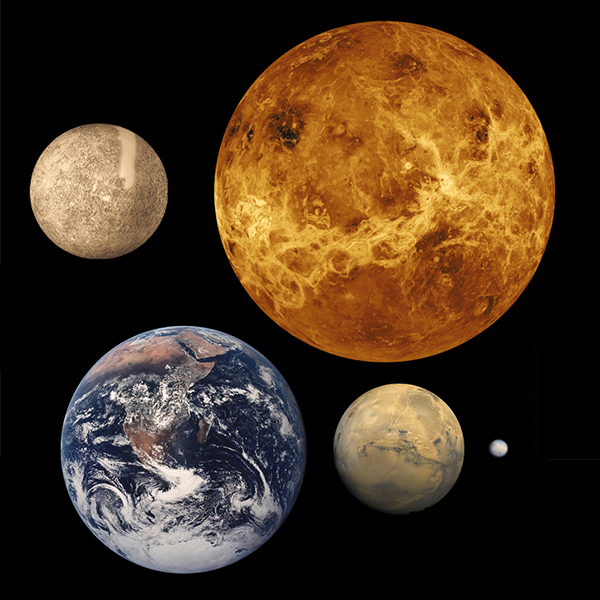
The rocky planets (Let’s Talk Science using an image by Weirdoinventor [Public domain], Wikimedia Commons)

The rocky planets (Let’s Talk Science using an image by Weirdoinventor [Public domain], Wikimedia Commons)
How does this align with my curriculum?
Earth is covered in rocks. So are Mercury, Venus, Mars and the Moon. Does that mean the rocky planets are all the same?
There are four rocky, or terrestrial, planets: Mercury, Venus, Earth, and Mars. These planets are called terrestrial planets because they are made up of rocks and metals and have solid surfaces. But even though they're made of the same materials, the four rocky planets in the Solar System aren’t the same.
In many ways, all the rocky planets are similar. They all have a solid rocky crust, some form of mantle, and a core. But there are important differences, too.
Let’s take a closer look at the rocky planets, inside and out.
Did you know?
The four rocky planets are the closest planets to the Sun.
What are the layers of Earth?
Let’s start with the planet we know most about: the Earth. The top layer is called the crust. That’s the layer where we live. The crust can be anywhere from 8 to 50 kilometres thick. Compare this to the Atlantic Ocean. It is only 8.486 km deep!
The next layer is called the mantle. It makes up most of Earth. It is made up of rocks and minerals. The mantle is made up of two parts: the upper and the lower portions. Because the inside of the Earth is very hot, the material within the mantle is molten. That means it’s able to move around. It’s kind of like thick molasses.
Under the mantle is the Earth’s core. It is made of nickel and iron. The Earth’s core has two parts: the outer core and the inner core. The Earth’s outer core is so hot that all the rocks and metals there have melted! They slosh around, creating Earth’s magnetic field.
At the very centre of Earth is the inner core. Though it is very hot, the metals there are compressed into a solid. That is because of the pressure from all the rock above.
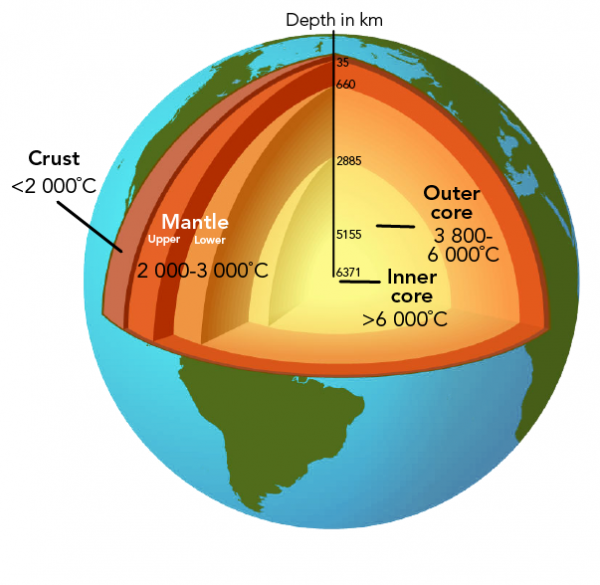
What are the layers of Mercury?
Next, let’s look at Mercury. Mercury’s surface is rocky and covered in impact craters. It most closely resembles the Moon. Like Earth, Mercury has a crust, mantle, and core.
Mercury is the smallest of the rocky planets. But it has the largest core! It is mostly made up of liquid iron. Mercury’s core fills over 60% of the planet’s total volume. In comparison, Earth’s core takes up only 15%.
Scientists aren’t exactly sure why Mercury has such a large core. They think that maybe Mercury was formed very early in the Solar System’s history from water vapour. That water vapour was probably created by objects called planetesimals. These planetesimals probably contained a lot of iron. This would help explain why Mercury’s interior is so rich in iron.
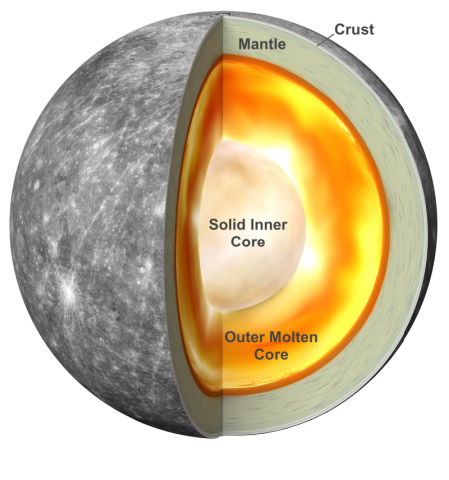
What are the layers of Venus?
Now, let’s look at Earth’s neighbour, Venus. Venus has a very similar size, mass and density to Earth’s. Because of this, scientists generally assume that the inside of the planet is very similar to Earth’s, too. Unfortunately, scientists do not know very much about Venus’ interior. It is difficult to study Venus because it has a very thick, dense atmosphere. Also, Venus is extremely hot!
Did you know?
Geologists who study the geology of the Earth’s Moon, other planets and their moons, comets, asteroids, and meteorites are called astrogeologists.
Unlike Mercury’s surface, Venus’ surface appears quite smooth. This is because there are volcanic plains all over Venus’ surface. Volcanic activity on Venus spreads fresh lava. Lava cools into new rocks.
Some scientists believe that volcanoes on Venus have recently erupted. They may even still be erupting. Venus may even go through phases where most or all of its volcanoes erupt at the same time. If this happens, then the whole planet is covered in new rock!
Out of all the planets in the Solar System, Venus has the most volcanic activity by far.
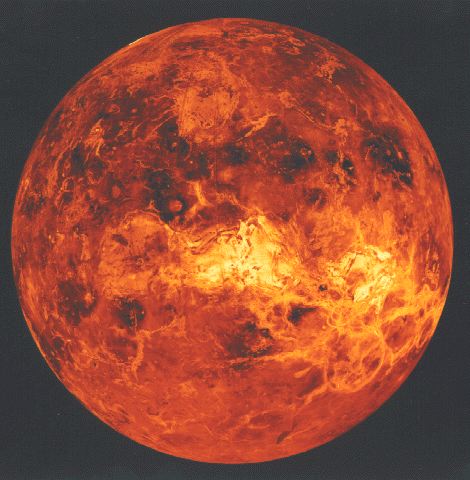
What are the layers of Mars?
Finally, let’s look at Mars. Mars has lost much of its internal heat. That means its core is at least partially solid. How do scientists know Mars used to have more internal heat? Because Mars is home to some of the largest volcanoes in the Solar System! Also, some of the planet’s oldest rocks are magnetized. That means that Mars once had a liquid core that created a magnetic field, just like Earth’s.
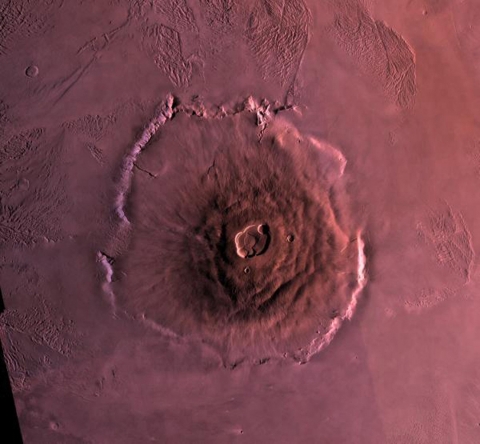
Did you know?
The largest volcano in the Solar System is on Mars. It’s called Olympus Mons.
How do we know what planets look like on the inside?
You might be wondering, how do we know all this? We can’t really take a giant knife and cut open the planets. So how do scientists know what the inside of planets looks like?
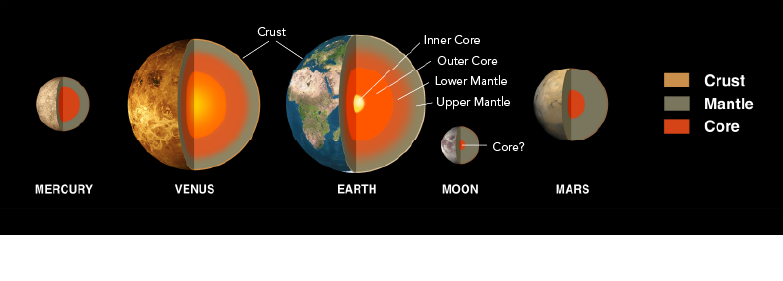
There are actually a few different ways to study the inside of a planet. For example, scientists can study a planet’s vibrations. When rocks move around, they cause vibrations. These vibrations give clues about what is happening inside a planet. Scientists can measure these vibrations with special motion sensors called seismometers .
There are seismometers located all over Earth. Astronauts even left a few seismometers on the Moon during the Apollo missions.
As for the other rocky planets, most of our information comes from satellites and other space probes. For example, Mariner 10 flew by Mercury in the 1970s. It provided scientists with a great deal of information about the planet. Venus Express orbited Venus between 2006 and 2014. It sent a lot of information about Venus back to Earth. Also, many different orbiters have been sent to Mars.
As an orbiter circles a planet, it measures the rocks on the surface. It also measures the entire planet’s mass. These two pieces of information provide a rough idea of what the inside of the planet might be like.
Did you know?
The planets farthest from the Sun -- Jupiter, Saturn, Uranus, and Neptune -- are called the gas giants. They are made up of a mixture of gases and do not have solid cores.
Scientists can’t literally look inside a planet, not even our own! But they still have ways of understanding what’s going on beneath its surface. In the case of the four rocky planets, seismometers and spacecraft have revealed many similarities and some important differences.
Starting Points
- Would you be interested in studying the geology of distant planets? Why or why not?
- What is the value of studying the rocky planets?
- Should governments spend money and use resources to send satellites and probes to distant planets?
- What are the rocky planets? What characteristics do they have in common?
- How have satellites been helpful in learning about the rocky planets?
- What is unique about the core of Mercury?
- What does the evidence of magnetized rocks on Mars indicate to scientists?
- How are investigations about space and celestial bodies different from typical science investigations and experiments conducted here on Earth?
- Can you think of any type of scientific investigations that are conducted on Earth that have strong similarities with research conducted in space?
- Why is the study of the planets a long-term proposition? If you were going to become a space scientist, what characteristics and skills do you think you would need to possess?
- Subterranean worlds have been the topic of books and movies over the years. For example, Jules Verne wrote the book Journey to the Center of the Earth in 1864. Do you know of any books or movies of this genre? What sources of inspiration does the book or movie have? What aspects of the book or movie seems based on scientific understanding of geology and the composition of a rocky planet? What aspects of the book or movie appears to be purely fiction?
- This article can be used to support teaching and learning for Earth Science, Earth materials/processes, Space Science and Space related to moons, planets, Earth’s interior and the rock cycle. Concepts introduced include terrestrial, Solar System, crust, mantle, molten, core, outer core, Earth’s magnetic field, inner core, Mercury, impact crater, planetesimals, Venus, lava, Mars, magnetized, seismometers, satellites and orbiters.
- Before reading this article, teachers could provide students with an Anticipation Guide to engage their prior knowledge of the rocky planets. Ready-to-use Anticipation Guide reproducibles are available in [Google doc] and [PDF] formats. The Answer Key is available in [PDF] format.
- After reading this article, teachers could have students develop a chart, graphic organizer or infographic that compares the characteristics and features of the layers of rocky planets.
Connecting and Relating
- Would you be interested in studying the geology of distant planets? Why or why not?
Relating Science and Technology to Society and the Environment
- What is the value of studying the rocky planets?
- Should governments spend money and use resources to send satellites and probes to distant planets?
Exploring Concepts
- What are the rocky planets? What characteristics do they have in common?
- How have satellites been helpful in learning about the rocky planets?
- What is unique about the core of Mercury?
- What does the evidence of magnetized rocks on Mars indicate to scientists?
Nature of Science/Nature of Technology
- How are investigations about space and celestial bodies different from typical science investigations and experiments conducted here on Earth?
- Can you think of any type of scientific investigations that are conducted on Earth that have strong similarities with research conducted in space?
- Why is the study of the planets a long-term proposition? If you were going to become a space scientist, what characteristics and skills do you think you would need to possess?
Media Literacy
- Subterranean worlds have been the topic of books and movies over the years. For example, Jules Verne wrote the book Journey to the Center of the Earth in 1864. Do you know of any books or movies of this genre? What sources of inspiration does the book or movie have? What aspects of the book or movie seems based on scientific understanding of geology and the composition of a rocky planet? What aspects of the book or movie appears to be purely fiction?
Teaching Suggestions
- This article can be used to support teaching and learning for Earth Science, Earth materials/processes, Space Science and Space related to moons, planets, Earth’s interior and the rock cycle. Concepts introduced include terrestrial, Solar System, crust, mantle, molten, core, outer core, Earth’s magnetic field, inner core, Mercury, impact crater, planetesimals, Venus, lava, Mars, magnetized, seismometers, satellites and orbiters.
- Before reading this article, teachers could provide students with an Anticipation Guide to engage their prior knowledge of the rocky planets. Ready-to-use Anticipation Guide reproducibles are available in [Google doc] and [PDF] formats. The Answer Key is available in [PDF] format.
- After reading this article, teachers could have students develop a chart, graphic organizer or infographic that compares the characteristics and features of the layers of rocky planets.
Learn more
Mars in a Minute: What's Inside Mars? (2018)
NASA fact sheet that includes a short video (1:00 min.) about how scientists find out information about the inside of a planet
Inside Planet Mercury (Infographic) (2010)
Infographic by Karl Tate including information about the inside of Mercury
Inside the Planet Venus (Infographic) (2012)
Infographic by Karl Tate including information about the inside of Venus
Inside Planet Mars (Infographic) (2010)
Infographic by Karl Tate including information about the inside of Mars
Could Life Be Floating in Venus’s Clouds? (2018)
Article by Kimberly M.S. Cartier discussing the possibility of Venus’ atmosphere being hospitable to microbes, and what this could mean for life on other planets
Signs of ancient rivers on Mars revealed in new images (2019)
Article by Liam James containing images of ancient riverbeds on Mars and the possibility that temperatures used to be higher on this planet
References
Andrei, M. (2018, August 21). What are the layers of the Earth? ZME Science.
Cofield, C. (2016, October 16). Volcanoes on Venus erupted recently, new study suggests. Space.com.
Gammon, K. (2019, February 08). Terrestrial planets: Definition & facts about the inner planets. Space.com.
NASA Jet Propulsion Laboratory. (n.d.). How do we see inside of a planet's crust?
NASA Mars Exploration. (n.d.). Orbiters.
Redd, N. T. (2012, November 17). What is Venus made of? Space.com.
Redd, N. T. (2016, October 14). What is Mercury made of? Space.com.
Sharp, T. (2017, December 12). What is Mars made of? Space.com.
Shiga, D. (2007, May 31). Lab study indicates Mars has a molten core. New Scientist.